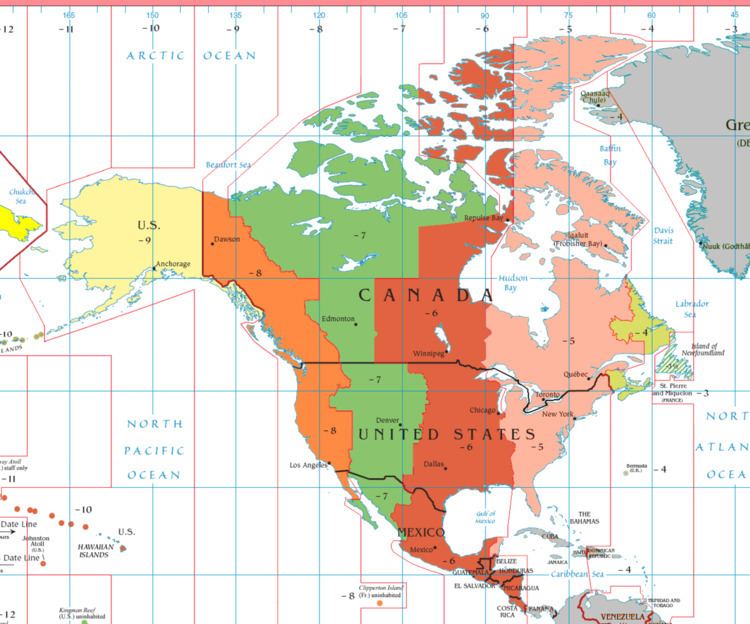EST UTC−5:00 DST ended Nov 6, 2016 | EDT UTC−4:00 DST begins Mar 12, 2017 | |
 | ||
EST 8:09 am on Mar 10, 2017 | ||
The Eastern Time Zone (ET) is a time zone encompassing 17 U.S. states in the eastern part of the contiguous United States, parts of eastern Canada, the state of Quintana Roo in Mexico, Panama in Central America, and the Caribbean Islands.
Contents
Places that use Eastern Standard Time (EST) when observing standard time (autumn/winter) are 5 hours behind Coordinated Universal Time (UTC−05:00).
Eastern Daylight Time (EDT), when observing daylight saving time DST (spring/summer) is 4 hours behind Coordinated Universal Time (UTC−04:00).
In the northern parts of the time zone, on the second Sunday in March, at 2:00 a.m. EST, clocks are advanced to 3:00 a.m. EDT leaving a one-hour "gap". On the first Sunday in November, at 2:00 a.m. EDT, clocks are moved back to 1:00 a.m. EST, thus "duplicating" one hour. Southern parts of the zone (Panama and the Caribbean) do not observe daylight saving time.
History
The Uniform Time Act of 1966 ruled that daylight saving time would run from the last Sunday of April until the last Sunday in October in the United States. The act was amended to make the first Sunday in April the beginning of daylight saving time as of 1987. The Energy Policy Act of 2005 extended daylight saving time in the United States beginning in 2007. So local times change at 2:00 a.m. EST to 3:00 a.m. EDT on the second Sunday in March and return at 2:00 a.m. EDT to 1:00 a.m. EST on the first Sunday in November. In Canada, the time changes as it does in the United States.
Canada
In Canada, the following provinces and territories are part of the Eastern Time Zone:
United States
The boundary between time zones is set forth in the Code of Federal Regulations, with the boundary between the Eastern and Central Time Zones being specifically detailed at 49 CFR 71.
The District of Columbia and seventeen states are located entirely within the Eastern Time zone:
Six states are split between Eastern and Central time:
Eastern Time is also used somewhat as a de facto official time for all of the United States, since it includes the capital (Washington, D.C.) and the largest city (New York City). National media organizations will often report when events happened or are scheduled to happen in Eastern Time even if they occurred in another time zone, and TV schedules are also almost always posted in Eastern Time. In the United States, all nationally televised morning programs (except Good Morning America Weekend Edition which some ABC affiliates on the east coast air on a tape-delay), some daytime talk shows, evening newscasts, most talent and awards shows, and any other nationally televised event that airs live on American television during prime time and on the weekends (such as sports television) are broadcast live in the Eastern Time Zone. Major professional sports leagues also post all game times in Eastern time, even if both teams are from the same time zone, outside of Eastern Time. For example, a game time between two teams from Pacific Time Zone will still be posted in Eastern time (for example, one may see "Seattle at Los Angeles" with "10:00 p.m." posted as the start time for the game, often without even clarifying the time is posted in Eastern time).
Most cable television and national broadcast networks advertise airing times in Eastern time. National broadcast networks (ABC, CBS, The CW, FOX, NBC) generally have two primary feeds, an eastern feed for Eastern and Central time zones, and a tape-delayed western feed for the Pacific Time Zone. The prime time is set on Eastern and Pacific at 8:00 p.m., with the Central time zone stations receiving the eastern feed at 7:00 p.m. local time. Mountain Time Zone stations receive a separate feed at 7:00 p.m. local time. As Arizona does not observe daylight saving time, during the summer months, it has its own feed at 7:00 p.m. local time. Cable channels with a separate western feed (such as HBO, whose western feed is called "HBOW") generally air the same programming as the eastern feed delayed by three hours. Other cable networks such as the Discovery family of networks repeat their prime time programming three hours later; this allows for the same show to be advertised as airing at "8:00 p.m. E/P" (that is, "8:00 p.m. Eastern and Pacific time"). Networks specializing in the airing of sports events, such as ESPN, advertise all of their programming in Eastern and Pacific, incorporating the 3-hour time difference (as in "8:00 p.m. Eastern/5:00 p.m. Pacific") and leaving viewers in the remaining time zones to calculate start time in their own areas.
Mexico
Caribbean Islands
The Bahamas officially observe both Eastern Standard Time during the winter months and Eastern Daylight Time during the summer months. Cuba is usually the same, with Eastern Standard Time in the winter, and Eastern Daylight Time in the summer, but it often changes on different days. Cayman Islands, Haiti, and Jamaica use Eastern Standard Time year-round. The Turks and Caicos Islands used to follow eastern time with daylight saving but switched in 2015 to the Atlantic Time Zone.
Central and South America
Panama, located in Central America, operates on Eastern Standard Time (UTC−05) throughout the year. Similarly, the Brazilian state of Acre and the southwestern region of the state of Amazonas, along with Colombia, Ecuador (excluding the Galápagos Islands, which observe Central Standard Time), and Peru in South America, adhere to Eastern Standard Time (UTC−5) consistently year-round.
